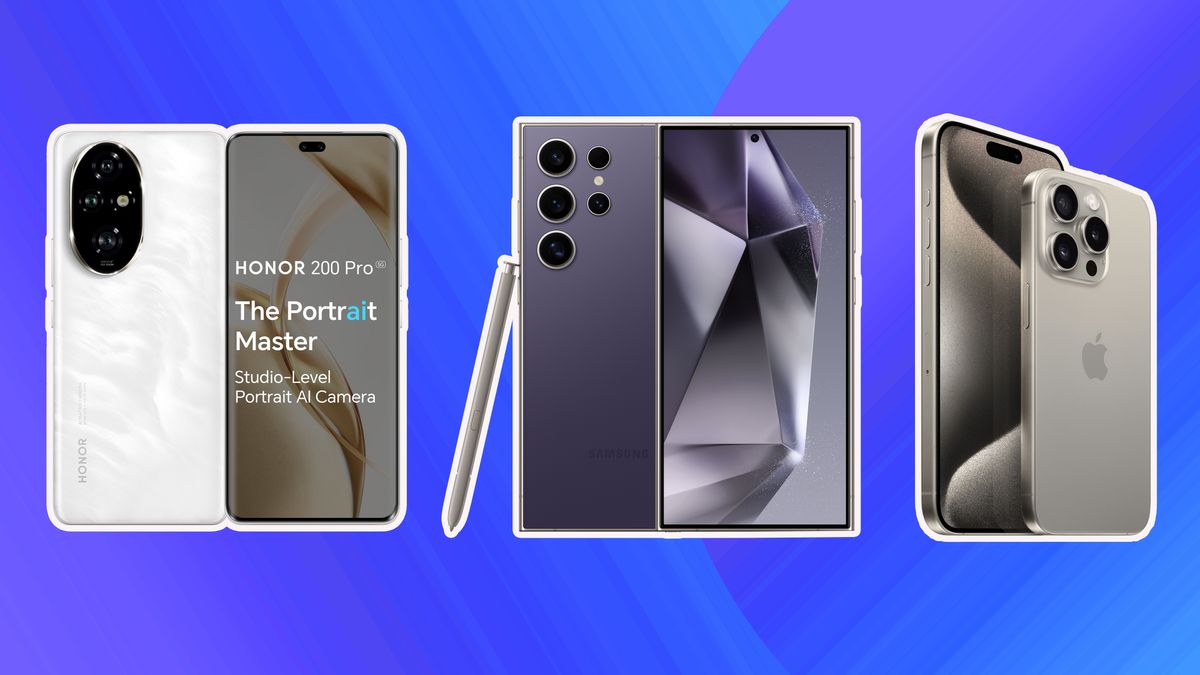The latest camera phones on the market are packing some seriously impressive megapixel power, and if you love photography (but hate the idea of carrying around a weighty DSLR), then owning one of the best camera phones is a no-brainer. Equipped with advanced AI imaging and high-end technology, these pocket-sized shooters can rival even professional mirrorless cameras, and are being used by pros in the industry too *cough* Rankin *cough*.
Whether you’re a diehard Samsung fan (like me) or prefer to use one of the best iPhones for photography to capture your smartphone snaps, a lot of these flagship camera phones come with hefty price tags. We’ve included some more affordable options (under $1,000), but if you’re really here for the best camera phone that money can buy, or to replace your “proper” camera setup, then expect to spend big.
As a photographer, I’ve picked out my top 10 favourite handsets below that I’ve tried and tested in the field recently, as well as some other recommendations based on our in-house reviews, hands-on experience, and detailed comparisons of key specs. We also have a guide to the best budget camera phones if our options below are a little out of your price range. We anticipate that the new Google Pixel 9 Pro will be a strong contender for this roundup, but we can’t offer an honest opinion or verdict until we get our hands on it.
Quick List

The Samsung Galaxy S24 Ultra is my current camera phone, and in my opinion, the best one on the market right now. It boasts features including an AI Camera Assistant, Generative Edit tools, low-light nightography, and 100X Space Zoom with super-resolution technology HDR imaging.
Read more below
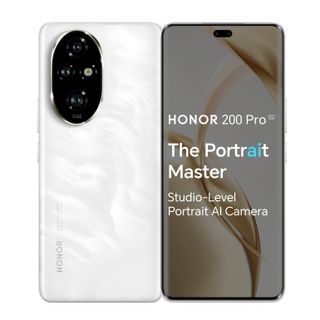
The Honor 200 Pro camera phone is fresh on the market, endorsed by Rankin, equipped with AI, and has unique in-camera filters produced in collaboration with Studio Harcourt, the famous Parisian studio founded in 1933. It’s also used and endorsed by photographer, Rankin.
Read more below
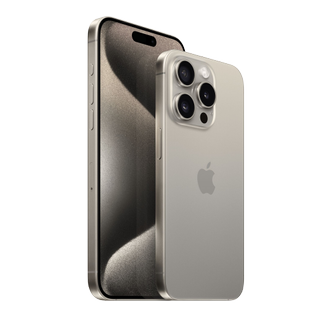
The iPhone 15 Pro Max is Apple’s latest product in the iPhone family, which by default makes it the best iPhone option for photographers. It’s only marginally different from other iPhone models, but it has a larger quad-pixel sensor for quality images.
Read more below
The best camera phones on the market right now
Why you can trust Creative Bloq
Our expert reviewers spend hours testing and comparing products and services so you can choose the best for you. Find out more about how we test.
The Best camera phone overall
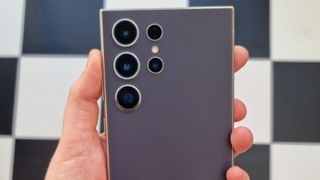

Specifications
Reasons to buy
Reasons to avoid
I own the Samsung Galaxy S24 Ultra and, it’s by far the best camera phone on the market right now (at least in my opinion) with a 200MP Quad tele zoom camera. I chose the S24 Ultra because camera quality is a key, if not the most important, feature for me as a photographer. But I also use my phone everyday fr social media, work, messaging friends and family, and taking snaps of my dog of course.
Since I use a lot of social media, like Instagram especially for photo sharing on my photography account, Samsung’s partnership with Instagram for the S24 series just made sense – and it allows for HDR uploads, native camera integration for creating stories and reels, and other excellent features.
The S24 Ultra delivers superb low-light quality images, even in the darkest conditions like at concerts and live shows. The quad-camera array gives you real shooting flexibility in every situation, and the 100x Space Zoom is a feature I haven’t given much attention to, but is still handy to have if you ever want to go stargazing.
Then we get to the AI. The Samsung Galaxy AI Photo Assist and Generative edit features offer a host of photo features to help you create your best work and take it to new levels. It has an AI-made watermark embedded into the metadata though, for ultimate transparency. The S24 Ultra is also the only model in the series with S Pen compatibility, which opens up a host of benefits from note-taking and photo editing, to Google’s Circle to search feature.
See our Samsung Galaxy S24 Ultra review for more details.
The Best camera phone for portraits
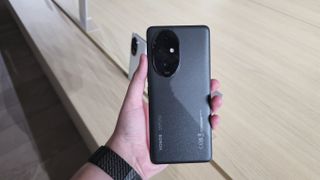

Specifications
Reasons to buy
Reasons to avoid
I was invited to Paris for the launch of the Honor 200 series of AI-powered smartphones, and I got hands-on experience with the 200 Pro model which is exceptional for photographers. It has a beautiful design too, and feels great to use.
I also attended a live demo where renowned photographer, Rankin, used the Honor 200 Pro smartphone to capture some truly stunning photos, so it’s safe to say that I can vouch for how great this camera phone is for visual artists. Take a look at Rankin’s 8-step method for smartphone photography to see how he uses the Honor 200 Pro for studio-quality portraits.
As for specs, this camera phone boasts a triple 50MP studio-quality camera array, featuring a portrait main camera (f/1.3), a telephoto camera with 50X digital zoom (and a customized telephoto sensor from Sony), plus an ultra-wide 12MP macro camera. The main camera also offers a 105% increase in noise reduction in low-light conditions, which is great if you’re someone who likes to take photos during a concert.
See our Honor 200 Pro review for more details.
The Best iPhone camera
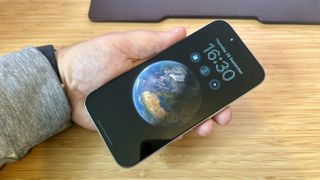

Specifications
Reasons to buy
Reasons to avoid
This entry is probably not surprising to most, but Apple‘s iPhone 15 Pro max still makes the cut as one of the best camera phones on the market despite lacking any kind of AI power behind the lens. If you’re strictly Team Apple, then this latest flagship iPhone is one of the best camera phones out there and probably your only choice if you’re not willing to jump ship over to Android camera phones.
The iPhone 15 Pro and Pro Max offer enough of an improvement over the 14 series to land on our list, even though it has the exact same main camera as the previous model, but with an upgraded sensor that uses pixel-binning (so really it only outputs at 24MP, not 48MP). It also has an upgraded 120mm telephoto lens, which offers 5x optical zoom and excellent macro capabilities.
With the iPhone 15 series, there’s the option to customise the default lens, and the phone can now shoot 48MP HEIF as well as Apple Raw. These are a handful of the very marginal differences in design and features.
You can read more in our hands-on Apple iPhone 15 Pro review for more details. And make sure you check out our essential iPhone Pro camera tips to get the most out of your new device.
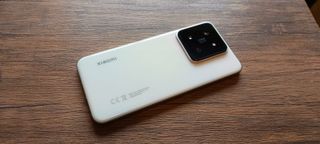
The Best Leica camera phone
04. Xiaomi 14
Specifications
Reasons to buy
Reasons to avoid
Our Reviews Editor, Erlingur, described this phone as “simply the best smartphone I’ve ever used” and “the world’s greatest phone camera” in his Xiaomi 14 review. This phone has two other siblings with slightly better camera arrays, the Xiaomi 14 Pro and Xiaomi 14 Ultra models, however these come at a greater price, and as we’ve proven – the standard Xiaomi 14 model is more than capable enough for most smartphone shooters.
It boasts a Leica-engineered camera with a one-inch sensor, and three 50MP lenses, which is a pretty impressive camera package in a phone camera. The megapixel count may not match the 100 or 200MP claims of other competitors (we’re looking at you Samsung), but what you get here is a lack of pixel binning and a resolution that is actually 50MP. The main camera has an f/1.6 max aperture, with complete manual control available should you choose to tinker around.
The one-inch Light Fusion 900 sensor, developed by Leica, gave our reviewer some incredibly dynamic images no matter the scenario. The 4K video recording offered crispness and clarity, and the macro photography features had staggering fidelity. On top of that, the Xiaomi 14 is equipped with a feature-rich, AI-boosted photo-editing app suite, with sophisticated filters (including several that impressively replicate the effect from classic camera film types), and even AI-enhanced portrait modes, with a dedicated animal-portrait function.
The Best selfie camera phone
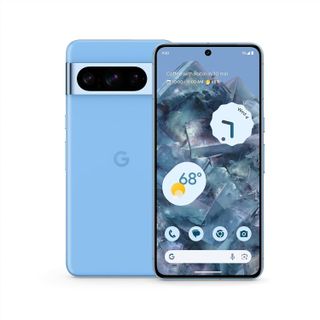
05. Google Pixel 8 Pro
Specifications
Reasons to buy
Reasons to avoid
The Google Pixel 8 Pro might have been replaced by the latest Google Pixel 9 range of smartphones with Gemini AI, but the Pixel 8 Pro model still remains to be one of the latest and best camera phones on the market right now. The Pixel 8 series is under a year old at the time of writing, and won the AI race as the very first smartphone to be launched with generative AI capabilities, thanks to its Google Tensor G3 chip.
An excellent choice for creatives and photographers, the Pixel 8 Pro has a triple-rear camera setup including a 50MP main camera, a 48MP ultra-wide lens, and a dedicated 5x telephoto lens, and also boats clever AI tools such as Magic Eraser to remove unwanted photobombers from your photos. There’s also the Best Take feature, which can pick out the best image from a series of shots, and means that you’ll always have everyone’s eyes open in group selfies. There’s also Video Boost and Night Sight Video for amazing quality footage.
The Best foldable camera phone

06. Samsung Z Fold6
Specifications
Reasons to buy
Reasons to avoid
The Samsung Galaxy Z Fold6 is one of the best AI-powered camera phones on the market right now, but the gimmick that sets it apart is the foldable screen that expands into a tablet-like form for large-screen photo editing and content streaming.
I got hands-on with the Galaxy Z Fold6 over at Samsung’s London HQ last month, and I was seriously impressed with the design and quality of this latest foldable flagship. Although, I do wish there were some better camera upgrades, considering that the Fold 6 still sports the same 50MP main camera as last year’s Fold 5, plus the same wide and optical zoom cameras. The 12MP ultrawide camera is supposedly brand-new according to Samsung, with a low-light enhanced sensor and better performance with HDR and noise reduction that has been adopted from the S24 series.
Thanks to Galaxy AI, the Fold6 not only has a great camera but can also make on-device generative edits and allows you to achieve maximum quality through features like Galaxy AI Photo Assist and Sketch-to-image, using the included S pen.
The Best Pro level camera phone
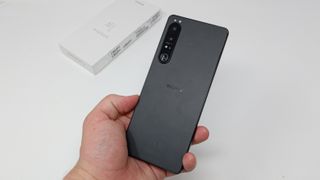
Specifications
Reasons to buy
Reasons to avoid
Sony’s been putting out some great cameras, so you would hope for good things from its camera phones, and the fourth-generation Xperia 1 doesn’t disappoint. It justifies its place on this list thanks to a few key features designed more for professional photographers than average consumers.
The zoom camera on the Xperia 1 IV has a moving lens, which facilitates continuous optical zoom between 3.5x and 5.2x, giving the phone a competitive edge for people who like zoom photography. The phone also sports a physical shutter button, which can be partially depressed to find focus or fully pressed to take a picture, giving a camera-esque experience.
Meanwhile, for the first time on a Sony phone, you can record 4K and 120fps footage on any of the three rear cameras and one on the front, which is useful for videographers and bloggers. We also quite like Sony’s creativity apps like Photography Pro and Cinema Pro (there’s also Audio Pro for music). The photography app isn’t the easiest to use since it’s modelled on cameras rather than smartphones, but if you’re familiar with using a DSLR, you’ll have no problem with it.
Read more in our in-depth Sony Xperia 1 IV review.
The Best Hasselblad camera phone
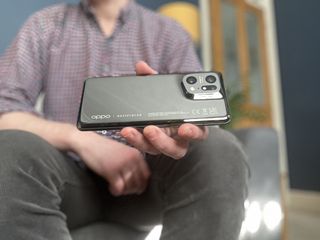
Specifications
Reasons to buy
Reasons to avoid
The Oppo Find X5 Pro was one of the most talked about top-end smartphones of 2022, and mostly because of its camera, thanks to help from Swedish camera manufacturer Hasselblad. There’s a 32MB selfie on the front and three lenses on the back neatly grouped into a kind of plateau: a main 50MP with a super fast f/1.7 aperture, an ultra-wide-angle 50MP camera with f/2.2 and a 13MP telephoto lens with f/2.4. Gone is the Find X3 Pro’s dedicated microscopic macro lens.
The two main lenses are fantastic with great, vivid colours and the low apertures allow fast shots. The telephoto lens is less impressive, with only a 2X zoom, which lags behind much of the competition. The new Marisilicon X neural processing unit applies AI imaging algorithms right on RAW data to improve noise reduction in low light for photos and 4K video. Meanwhile, Hasselblad’s filters that can add a film-like quality to the most mundane of images.
Cameras aside, the Oppo Find X5 Pro has a unique, sleek design – its camera bump is a smooth slope rather tan a clumsy protrusion. The display is also very good and highly adjustable.
Read more in our in-depth Oppo Find X5 review.
The Best panorama camera phone
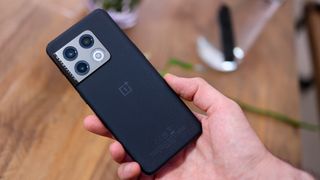
Specifications
Reasons to buy
Reasons to avoid
OnePlus’s high-end phone from 2022 offers an impressive trio of rear cameras, with the company’s partnership with pro camera manufacturer Hasselblad paying off again. We found the main, ultra-wide and telephoto cameras offer a lovely shallow depth in a lot of shots, although some might feel the AI optimisations leave the pictures a little oversaturated.
There are some unique modes available. XPan, inspired by the niche Hasselblad camera of the same name, takes wide panoramas, while 150-degree mode uses the ultra-wide camera to create a fisheye-like effect.
Beyond the camera, we found the OnePlus 10 Pro to be a well-rounded Android phone with a good-looking screen, fast charging and plenty of processing power. As with all phones, it has a few rough edges, and we found it ran hot when put through intense use. OnePlus has since released an update, the OnePlus 11 (there’s no Pro version coming anytime soon), and while it is a little cheaper and sports some camera upgrades, it lacks the 150-degree ultra-wide module on the 10 Pro.
Read more in our in-depth OnePlus 10 Pro review.
The Best macro camera phone
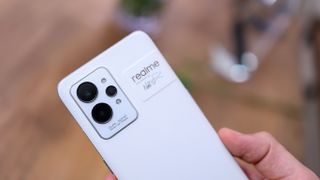
Specifications
Reasons to buy
Reasons to avoid
Realme isn’t a company that often gets onto ‘best camera phone’ lists, generally due to its lack of top-end smartphones, but the GT 2 Pro is its first top-end phone and it wins Realme a place on this list. The phone’s 50MP main and ultra-wide cameras are great, but the real reason the phone is on this list is its 40x magnification microscope camera.
We found Realme’s mobile miraculous for how it offers impressive camera features at a much lower price than you’d expect. The main camera is incredible for low-light photography, and would definitely give an iPhone a run for its money. It also captures loads of colour and light in daylight or well-lit settings.
We had loads of fun playing about with the microscope camera, and this is a great phone for a few other reasons too. It charges quickly, its screen looks great, and it’s very powerful. Plus, it’s one of the most affordable mobiles on this list, making it a great alternative to the big flashy phones from the bigger brands.
Read more in our in-depth Realme GT Pro 2 review.
How to choose
When choosing the best camera phone for photography and daily use, it’s easy to get overwhelmed by all of the choices available. There’s no singular camera phone that’s perfect for everyone, but in our minds, the Samsung Galaxy S24 Ultra comes pretty close, as does the Honor 200 Pro. But what about Apple fans? I personally don’t like iPhones (or any other Apple products for that matter) but some people don’t get on with Android either. That’s why we’ve picked these 10 options, with different users in mind.
We suggest that you start by looking at your budget, and assess how much you wish to spend on a camera phone first. Then consider the desirable features you’d want in a camera phone that would make it a great asset for your daily photography. Remember, it’s not always about megapixels. If you shoot a lot of video or TikTok content, then you’ll want a camera phone with at least 4K capability.
You’ve also got to think about the overall strengths of each camera phone, what does the device focus on? Some camera phones have long-ranging zoom cameras, either optical, digital, periscope or a combination. Others might focus on having a larger sensor or quad-pixel size, or a dedicated macro lens, whereas the newer models on the market seem to be all about AI and internal software upgrades, rather than physical lens enhancements.
Some brands offer exclusive features and will create their own camera modes too, for example, OnePlus and Oppo have some gorgeous Hasselblad-created filters – while newer Xiaomi models have been jointly developed with premium Leica cameras and lenses. Of course, you’ll need to consider other elements of the phone too. You’re choosing a camera phone to use every day, not just a camera, so consider the processing power, screen quality, app compatibility, battery life, and the size of the device you want.
Finally, the general shooting experience should also factor into your decision. Some camera phones will offer an easy point-and-shoot process so that you can take social-media-ready shots at the tap of a button, whereas other models might have a more involved process that makes it easy to tinker with different settings and shoot RAW for fine-tuned results. Your choice will depend on your comfort levels with using cameras, and experimenting with key elements in photography such as ISO, shutter speed, and aperture settings.
How we test
At Creative Bloq, we enjoy putting camera phones through their paces when it comes to testing, with benchmarks in place to measure battery life, response rate, general use – and the camera, of course. Although manufacturers carry out their own testing on phones, we think it’s important to have an unbiased reviewer (preferably a photographer) on the case to detect any flaws or find genuine reasons why we think a camera phone might not be the best fit for creatives or up to scratch when compared with competition.
We do this by using social media and checking the upload speeds, running photo editing software, streaming video content, and testing the camera in different real-world scenarios. You can look at a spec sheet all you want (and believe me, we do), but really, nothing beats getting a camera phone in your hands and having a play around with the different lenses and features. Doing this for long enough will allow you to get a good feel for the handset and the general photography experience it offers.
That’s what we’ve done with the majority of the camera phones above. And where we haven’t had a chance to review the model ourselves, we’ve consulted others in the business, including our sister sites such as Digital Camera World and TechRadar to pick their brains. Our writers are professional photographers and keen enthusiasts, with a good understanding of what consumers are looking for in a modern camera phone. For more information, see our guide to how we test and review at Creative Bloq.
FAQs
How much do the best camera phones cost?
None of the phones in our pick of the best camera phones are cheap. Based on the manufacturers’ recommended retail prices, our recommended choices for the best camera phone range from $699 / £699 for the Realme GT 2 Pro to over $1,000 / £1,199.00 for the new iPhone 15 Pro Max, and a staggering $1,899.99 / £1,799 for the Galaxy Z Fold 6 – and those prices are for the starting configurations.
With that said, some of the phones on our list are more likely to see discounts than others. Samsung occasionally offers deals on its phones, especially during events like Black Friday and Amazon Prime Day, whereas Apple is more reluctant to slash its prices. Your best bet to save on an iPhone is through a trade-in, using the Apple Student discount benefits, or through a deal with a phone carrier. Google’s Pixel 8 Pro is also seeing some great deals at the moment, because of the anticipated release of the Pixel 9 series.
Are camera phones as good as digital cameras?
This is a slightly more complex question. In certain ways, camera phones have physical limitations that make them inferior in many ways to the best cameras. The big one is sensor size – smartphones must use physically smaller sensors than cameras. Larger sensors can use larger individual pixels, which creates a cleaner image with less noise and makes for better low-light performance.
However, clever computational tricks mean that camera phones are catching up. For instance, the 200MP camera on the Samsung Galaxy S23 isn’t really for capturing 200MP images (though it can), it’s designed to use a technique called pixel binning that combines several pixels into one, creating a digital simulation of the larger pixels on a camera’s sensor. This improves image clarity, and makes shooting modes like Night Photography much more potent.
Of course, some people will always prefer the form factor of a real digital camera, and we haven’t even touched upon the advantage (and expense) of being able to swap lenses. Remember, cameras and camera phones each have their place, and neither one is empirically ‘better’ these days.
